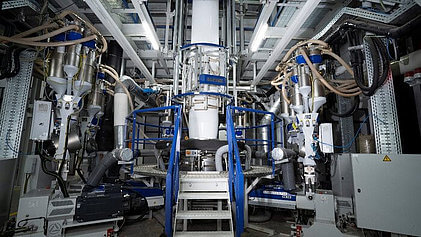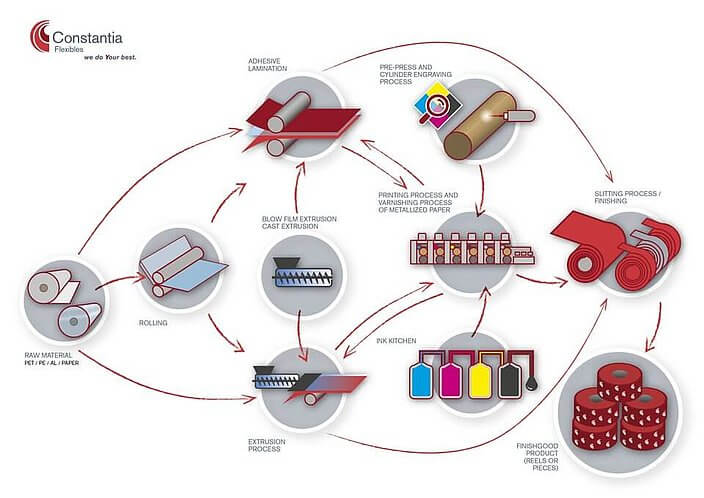
Film Technology
Film based production technology
Get in Touch
Step 1. Film production
Cast extrusion
With this type of extrusion the granule is melted and shaped by means of application through a die. The application is done directly on a cooling roller for quenching the liquid polymer film. After cooling the film material is reeled up. Due to coextrusion technology the film material can consist of up to 5 different layers and therefore allows optimized adaptation of the film material to customer requirements and needs. With cast extrusion it is possible to produce film material consisting of different granules within a range of 15 – 150 microns and a width of up to 2450 mm.
Blow Film
Step 2. Basic converting
Metallizing
In a high vacuum chamber a metallised layer is being applied on film material due to vaporising of aluminum particles. The metallizing can either be applied full coverage or striped. Besides optical value adding the metallizing gives an improved oxygen and steam barrier to film material.
Step 3. Printing
Rotogravure
Foil material as well as laminates are printed with engraved steel core cylinders and solvent based inks. The design is engraved into a copper layer on the cylinders which are then chrome plated – the excessive colour on the surface is removed with a doctor blade so that only the ink in the engraved cells remains and prints on the substrate. On our rotogravure machines we can print designs consisting of up to 10 colours including back side printing facilities – additionally further converting (such as hotmelt, cold seal or over lacquering) is possible in line.
Flexography
Flexographic printing, or flexography, is a direct, high-pressure, relief printing process on a rotary web press. It uses flexible printing plates or endless rubber sleeves and low-viscosity, solvent-based printing inks. ‘Direct’ means the ink is transferred directly from the printing plate to the material being printed. ‘Relief’ means printing area is in 3D relief. Flexography is a very popular technique for printing packaging made of plastic, paper, card, cardboard, etc. It’s also used for products such as adhesive films, insulating paper, carbon-backed paper, paper napkins and wallpaper.
A printing unit on a flexographic press is generally a bank of rollers. An anilox roll picks up a controlled amount of ink, a doctor system wipes off excess ink from the anilox roll, before it transfers the ink to the print plate. The print plate, mounted on the the print cylinder, transfers the ink to the web of paper or other material being printed. The web runs between the print plate and an impression cylinder, keeping the contact pressure constant. Today’s flexographic presses generally have between 4 and 10 printing units, arranged either in sequence or as satellites around a central cylinder.
UV-Flexo printing
Foil material and laminates are printed with photopolymer clichés and UV-curable inks which are environment-friendly due to solventless application. The design is printed with increased elements on the cliché that are coloured with an anilox roller with doctor blade system. Due to the high resolution of 70 lines per cm also photo realistic designs can be printed in quality comparable to rotogravure printing. On our UV-Flexo printing machines we can print designs consisting of up to 8 colours. Due to an in line rotogravure unit further converting based on solventless lacquer systems – either on front side or back side – is possible.
Step 4. Lamination
Extrusion
Polyethylene and polypropylene are manufactured on our own extruders according to specifically set-up formulations into single and multi-layer films with precisely defined properties as regards sealability, clarity, density, tearing strength, elasticity etc. This allows us to fulfil special requirements and technical or food safety-specific demands. Polyethylene film as well as polypropylene films can be produced from 15 µm up to 250 µ.
Solvent-based & solvent-free
Step. 5 Converting & finishing
Slitting
With our slitting machine we cut our reels into narrower lanes and reel diameter according to customer demands to ensure that it fits to our customers´packaging lines.
Die cutting
With a cutting tool consisting of stamp and die the lids are pressed out of the converted reels. The cutting tools are individually made according to the required shape – the most common shapes are available as standard tools. Additionally we can do in line embossing of the lids with all various kinds of embossing designs. As a special application also sectional embossed or deep drawn shapes are possible.
Reel cutters
Reel cutters slit the web longitudinally into two or more narrower reels. The cutting process splits up the huge rolls that come off the printing press into custom sizes for the customer’s packaging process. This can involve the size of the inner sleeves, the winding angle and direction and the maximum reel diameter. In the cutting process, the web passes at high speed between sharp, rotating upper and lower knives positioned to cut the precise widths required.

